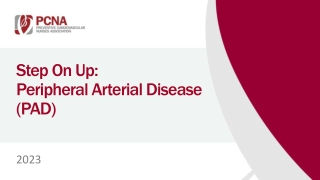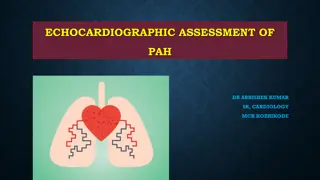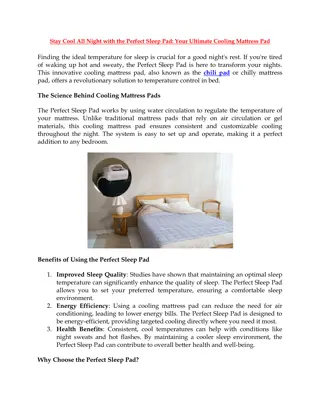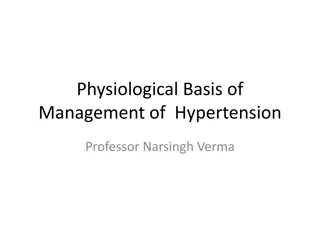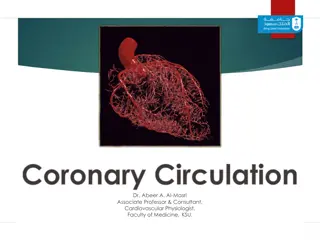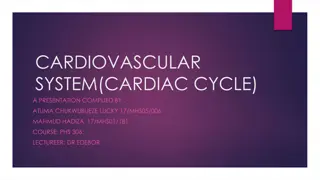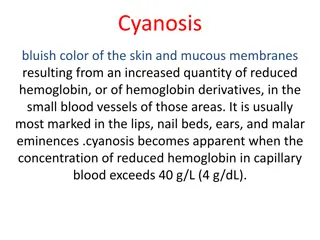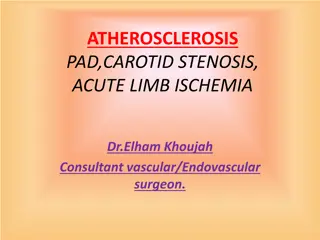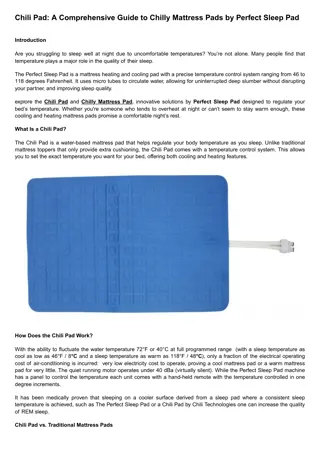Understanding Peripheral Arterial Disease (PAD) - Overview and Management
Peripheral Arterial Disease (PAD) refers to the narrowing of blood vessels outside the heart and brain, leading to reduced blood flow. This condition can result from atherosclerosis, inflammation, embolism, or thrombus formation. Learn about the causes, symptoms, diagnosis, and treatment strategies for PAD to enhance patient care and management.
Download Presentation

Please find below an Image/Link to download the presentation.
The content on the website is provided AS IS for your information and personal use only. It may not be sold, licensed, or shared on other websites without obtaining consent from the author. Download presentation by click this link. If you encounter any issues during the download, it is possible that the publisher has removed the file from their server.
E N D
Presentation Transcript
Peripheral Arterial Disease Dr. Rehab F.M.Gwada
Objectives of the Lecture The student at the end of this lecture will be able To define Peripheral Arterial Disease(PAD)& associated risk factors. To describe its causes &pathogenesis. To explain the clinical pictures associated with PAD to diagnose PAD& outline appropriate treatment goals? To describe the strategies of Treatment in patient with PAD ?
Content of Lecture What is Peripheral Arterial Disease? What are the risk factors for PAD? Peripheral Vascular Disease Causes& Pathogenesis Symptoms of PAD How do we diagnose PAD? Goals of treating patients with PAD the strategies of Treatment in patients with PAD
Arteries Large elastic arteries have walls consisting of: Tunica Intima Tunica Adventitia Tunica Media Consist of endothelium, subendothelium & elastic tissue Function: to prevent intravascular clotting Consist smooth muscle &elastic fiber Function: propel the blood of: Consist connective and small blood vessels Function: prevent expansion artery of tissue to to undue of
Peripheral Vascular Disease (PVD) refers to diseases of blood vessels outside the heart and brain. It's often a narrowing of vessels that carry blood to the legs, arms, stomach or kidneys. There are two types of these circulation disorders Functional peripheral vascular diseases don't have an organic cause. They don't involve defects in blood vessels' structure. They're usually short-term effects related to "spasm" that may come and go. Raynaud's disease is an example. It can be triggered by cold temperatures, emotional stress, working with vibrating machinery or smoking. Peripheral Vascular Disease Organic peripheral vascular diseases are caused by structural changes in the blood vessels, such as inflammation and tissue damage. Peripheral artery disease is an example. It's caused by fatty buildups in arteries that block normal blood flow. PVD definition is from the American Heart Association
What is Peripheral Arterial Disease? Peripheral arterial disease (PAD), commonly referred to as peripheral artery occlusive disease (PAOD), refers to the obstruction of large arteries not within the heart vasculature, or brain. PVD can result from atherosclerosis, inflammatory processes leading to stenosis, an embolism, or thrombus formation. It causes either acute or chronic ischemia (lack of blood supply). Often PAD is a term used to refer to atherosclerotic blockages found in the lower extremity.
Signs &Symptoms About 20% of patients with mild PAD may be asymptomatic; other symptoms include: Claudication - pain, weakness, numbness, or cramping in muscles due to decreased blood flow. Claudication walking induced pain in one or both legs [primarily affecting calves] does not go away with continued walking , relieved by rest Present in 15-40% of PAD Associated with diminished ability to perform ADL
Signs &Symptoms Noticeable change in color (blueness or paleness). Paleness of the leg or foot when elevated Blue/red discoloration of the foot when hanging down Absence of pulses in the foot. coolness. Diminished hair and nail growth on affected limb and digits. Sores, wounds, or ulcers that heal slowly or not at all. gangrene of the digits.
How do patients with PAD present?
What are the risk factors for PAD? Non-Modifiable Risk Factors: Male gender Advanced age Family history Modifiable Risk Factors: Major Smoking Hypertension Diabetes Hyperlipidemia Minor Homocystenemia Obesity Hypercoaguable state Physical inactivity
Peripheral Vascular Disease Causes atherosclerosis. Blood block: can block a blood vessel (thrombus/emboli). Diabetes: Over the long term can damage blood vessels Inflammation of the arteries: This condition is called arteritis and can cause narrowing or weakening of the arteries.
Peripheral Vascular Disease Causes Infection: The inflammation and scarring caused by infection can block, narrow, or weaken blood vessels. Structural defects narrowing. Most of acquired at birth, and the cause remains unknown. Injury Blood vessels can be injured in an accident can cause are these cases
How do we diagnose PAD? History & symptomes Physical Examination Capillary filling time:(2-3sec in worm day to 5sec in cold one) Test for rubor Non-invasive tests ABI(Ankle Brachial Index) measurement Segmental Pressures Exercise Test Doppler & duplex ultrasound, MR angiography. Invasive test (Contrastarteriography)
Test for rubor Changes in skin color that occur with elevation and dependency for the limb are evaluated. The legs are elevated & supported for 45 degree for one minute above the level of the heart while the patient is lying supine. severe , wide Pallor of the skin will occur in the feet if arterial circulation is poor (within 25 sec. indicate severe ischema) . The time necessary for blanching to develop is noted. The legs are then placed in a dependent position, and the color of the feet is noted.
Test for rubor Normally in dependency, a pinkish flush appears in the feet after several seconds(10sec). Abnormally , in severe ischemia , the delay is 40 sec or more. In occlusive arterial disease, a bright reddening or rubor of the distal legs and feet occurs. The rubor may take as long as 25 to 40 seconds to appear. Dependent rubor. Note the reddish appearance of the left leg and foot on dependency compared to the normal color of the patient s right foot and leg
Ankle Brachial Index ABI= Ankle SBP/ Arm SBP
the severity of the PAD Ankle Brachial Index ABI value Indicates <0.9 0.8- 0.9 0.5- 0.8 <0.5 <0.25 Abnormal Mild PAD Moderate PAD Severe PAD Very Severe PAD
PAD Diagnostic Test: Segmental Pressures arteries of your leg. Similar to the ABI plus 2 or 3 additional blood pressure cuffs. These additional cuffs are placed just below the knee and one large cuff or two narrow cuffs are placed above the knee and at the upper thigh. These cuffs are then inflated above your normal systolic blood pressure, and then slowly deflated. Using significant drop in pressure between two adjacent cuffs indicates a narrowing of the artery or blockage along the arteries in this portion of your leg. This allows the physician to identify more precisely the location of such blockages in the arteries of your leg . the Doppler instrument, a
Goals of treating patients with PAD Relief symptoms Limb salvage Improve quality of life Prolong survival
Strategies of Treatment for patients with PAD Risk Factors Modification Improve Lower Limb Circulation
Treatment of patients with PAD Risk Factors Modification Smoking Cessation Hypertension control Diabetes control Regular exercise Diet and weight control Lipid control
Treatment of patients with PAD Improve Lower Limb Circulation Conservative (Exercise Program): -Graded ambulation program - Burger-Allen Exercise Antiplatelet( reduce risks of MI , ischemic stroke vascular causes). Intervention ( Revascularization) - Angioplasty +/- Stenting - Plaque excision - Surgical Bypass - Rarely, sympathectomy is used. - amputation is often a last resort to stop infected ( In gangrene). or bicycling and death from
Angioplasty File:PTCA Schneepflug.jpg File:PTCA Schneepflug.jpg
Graded ambulation or bicycling program The patient should be encouraged to walk or bicycling far as possible, without causing intermittent claudicationas carried out 3 to 5 days per week mild warm-up activities before initiating ex. include stretching calf ms , isometric pumping ex. For ankle & toes
Graded ambulation or bicycling program Precautions: avoid exercising outside during very cold weather wear shoes that fit properly and will not cause skin irritations, blisters, or sores Patient with a history of cardiac disorders , must be monitored closely
Graded ambulation or bicycling program Contraindications: : leg pain increased over time Patient with resting pain ulcerations of the feet and wound or fungal infections
Burger-Allen Exercise First position(stage) Procedure: A three-stage exercise procedure is carried out 3times /day. Patient lies supine with legs elevated and supported at a 45 to 60 degree angle. Maintained position for 1 to 3 minutes, or until blanching of the extremity occurs actively dorsiflex and planterflex the feet
Burger-Allen Exercise Second position(stage) sits up and dangles his feet over the edge of the bed.. actively dorsiflexes and planterflexes his ankles for 3 minutes or until rubor in the feet develops.
Burger-Allen Exercise Third position(stage) supine with his feet and legs covered with a blanket for warmth and rests for 5 minutes. The procedure is repeated 3 to 6 times during each treatment session. entire three-stage
Burger-Allen Exercise Termination: Exercises and elevation of the limbs are discontinued if pain or cramping of the calf muscles occurs. Contraindications: -Recent acute thrombosis or embolus. -Increased swelling in the lower extremities
Prognosis Individuals with PAD have an elevated risk for cardiovascular events and the majority will eventually die of a cardiac ( 40%-60%) or cerebrovascular(10%- 20%) etiology prognosis is correlated with the severity of the PAD as measured by the Ankle brachial index (ABI). In patients with intermittent claudication, the risk of death from coronary events is three to four times higher than matched controls without claudication. Severity of PAD is closely associated with risk of MI , ischemic stroke , and death from vascular cause .
Question Discuss the Strategies of Treatment for patients with PAD? Thank you


